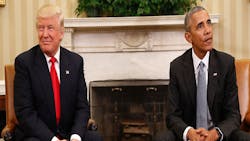President Obama has relied on, and expanded, the power of the administrative state by making substantial use of both executive orders and presidential memoranda to achieve policy objectives. Executive orders are appealing to any president because they can be quietly and quickly implemented without hearings, votes or substantive public feedback. President Obama has been direct in favoring this approach, stating, “We’re not just going to be waiting for legislation in order to make sure that we’re providing Americans the kind of help they need. I’ve got a pen and I’ve got a phone.”
The National Association of Manufacturers (NAM) ramped up its litigation in response to the tsunami of regulations coming out of the White House. In this final year of the president’s term, the regulatory spigot has only been turned up. The NAM is currently suing the federal government in 16 cases for overregulation.
The Manufacturers’ Center for Legal Action has argued in the courts that the president overstepped his constitutional power in issuing many memoranda and executive orders affecting labor and environmental law. However, a presidential legacy implemented by the pen can be destroyed by the pen. First, an executive order can be revoked by another executive order, and it is common for presidents to revoke some of their predecessors’ executive orders. Second, Congress can revoke an executive order through legislation. Third, an executive order can be revoked by a federal appeals court or the Supreme Court.
This year’s election will have a profound impact on future NAM litigation efforts to limit executive overregulation through the courts. President-elect Trump will fill the Supreme Court vacancy created by Justice Antonin Scalia’s death and potentially two or more additional seats as justices retire. If multiple vacancies occur, the Court will shift from its previous makeup of five conservative and four liberal justices that shaped some of the nation’s most significant issues on social norms, individual rights, the balance of government powers and business and workplace matters. Several if not all of the cases in which the NAM is suing the government for executive overreach may end up in a newly configured Supreme Court, and the outcome of President Obama’s regulatory legacy will largely rest on the Supreme Court nominees of President-elect Trump.
ShopFloor is the blog of the National Association of Manufacturers (NAM).
